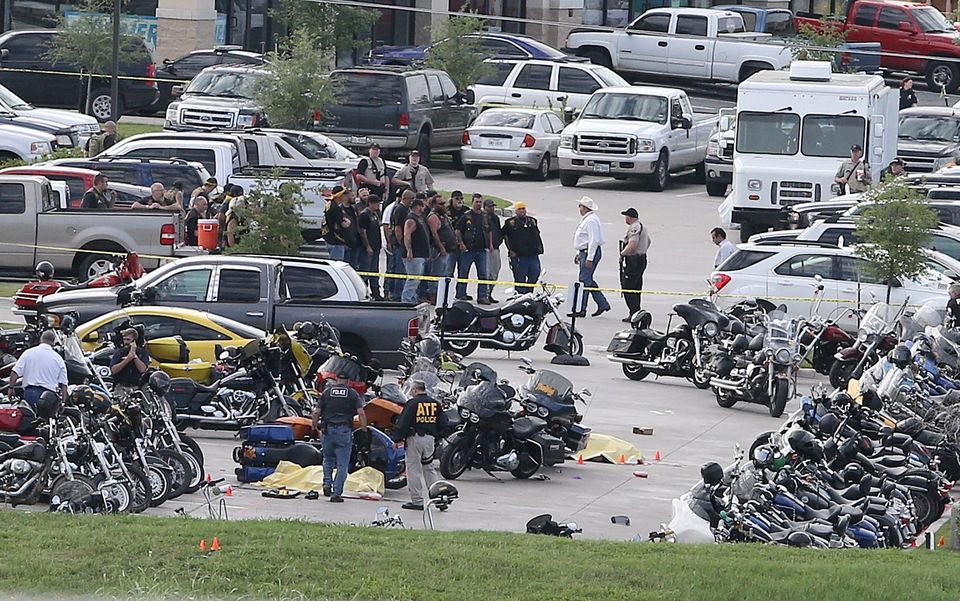Former undercover agent Jay Dobyns says people can be forgiven for thinking Sunday’s biker bloodbath in Waco, Texas, was a throwback to a bad 1970s movie.
The shootout — which killed nine people and wounded 18 — seemed aberrant because the public image of many motorcycle gangs has been burnished in recent years thanks to the many largely benign bike enthusiasts who’ve co-opted some of the same clothing and style.
«I think, as a society, and to a large extent even in law enforcement, we fall into the sense that these guys are these big, rough-looking teddy bears that do blood drives and toy runs and are harmless,» says Dobyns, who infiltrated the notorious Hells Angels Motorcycle Club for the federal Bureau of Alcohol, Tobacco and Firearms. «These are people that have used the motorcycle culture as camouflage.»
The more sinister side of biker culture was thrust into the spotlight after Sunday’s shooting in the parking lot of a restaurant where members of several rival gangs were having a meeting. By Monday, authorities had charged about 170 gang members with engaging in organized crime.
Motorcycle culture’s image problem goes back at least to 1947, when a race in Hollister, California, descended into two days of bloody riots. The American Motorcycle Association, the race’s sponsor, responded to the coverage by declaring that 99 percent of participants were law-abiding.
To this day, gangs like the Outlaws refer to themselves as «1 percenters,» says Terry Katz, former commander of the Maryland State Police’s organized crime section. Trouble is, it’s sometimes hard to tell the dark side of motorcycle groups from the light.
Even the terminology is interchangeable.
Good and bad alike call their organizations «clubs.» Both use the term «colors» for the emblems on the backs of their jackets and vests.
«Wear your colors with pride,» advertises a California company that makes patches for biker clubs, law enforcement agencies, fire departments, even the Boy Scouts of America.
Don Chambers, founder of the Bandidos gang, modeled his club’s emblem — a sombrero-wearing Mexican caricature carrying a sword and pistol — after the corn chip company’s Frito Bandito mascot, says Katz, who went undercover in the 1970s as an associate to two clubs, the Pagans and the Phantoms. Other clubs that want to operate on their turf are required to wear a patch called a «support cookie,» so named because it’s the size and shape of a cookie.
«You have a major gang. Then you have like a puppet club or you can call it a farm team that is part of their organization. But they’re not a member of the big dogs,» says Katz, vice president of the International Outlaw Motorcycle Gang Investigators Association.
The names have also grown more sinister. The Boozefighters and Pissed Off Bastards of Bloomington of 1947 Hollister have given way to the Outlaws, Cossacks and Hells Angels of today.
Katz says bikers maim and kill each other all the time. The only thing unusual about the Waco confrontation was that it happened in public.
«I get that question all the time: ‘Are these guys still around?'» he says. «Of course, they are. But they’ve lowered their profile, because it’s bad for business to be involved in something where you’re going to attract a great deal of law enforcement attention. They’ve never gone away. In fact, they’ve grown.»
Some clubs boast chapters on the other side of the globe.
«You look at crime syndicates. They come to America from other places,» says Dobyns, who lives in Tuscon, Arizona. «But the biker culture? That is America’s export to the … world of crime syndicates.»
Part of the problem, Dobyns says, is that the entertainment world tends to glamorize these groups.
The Hollister riots spawned «The Wild One,» Marlon Brando’s 1953 classic. But Johnny, with his dungarees turned up at the ankles and cap at a rakish angle, seems quaint compared to FX Networks’ «Sons of Anarchy.»
«They prey on the Americana of it,» says Dobyns, who used his own childhood nickname of «Jaybird» in his undercover work. «And it’s sexy and it’s glamorous. The reality of it is that it’s a very dangerous world, inhabited by violent men. And the reality of it is that it’s very unsexy and it’s very unglamorous.»
FX spokesman John Solberg declined to respond to Dobyns’ comments.
Like the Mafia, motorcycle gangs aren’t interested in big public displays, says Katz. But the cornerstone of that culture is a willingness to kill — and die — for your club.
«And that’s what you saw yesterday,» he says. «I mean, there were marked police cars outside that event … Once the fight started, it didn’t matter.»





